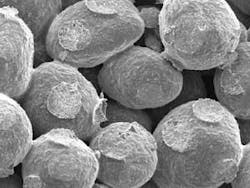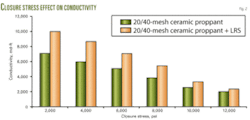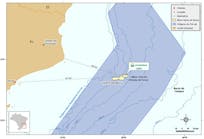Screenless frac-packs extend PetroChina well production
During field trials, PetroChina successfully installed screenless frac-pack completions to control proppant flow-back, thereby extending the life of marginally producing wells in Jidong oil fields.
Previous completions with premium screens and high-rate water packs required, on average, a workover every 2-3 months to clean out proppant, formation sand, and fines that greatly reduced production. Sand production also caused erosion damage to sand-control screens and surface equipment and plugging of electric submersible pumps (ESPs).1
The operator, therefore, considered screenless frac-pack completions using a tip screen-out design and a newly developed curable resin for controlling flow-back of formation sand and proppant.
Field results of these screenless frac-packs indicate that on-the-fly resin coating treatment effectively stopped the proppant and formation sand from producing back while maintaining the production rates as designed. The jobs have decreased substantially the number of workovers compared to wells left untreated.
The key to PetroChina’s success is a liquid resin system (LRS) that is 100% curable, unlike the resin applied to resin-precoated proppants (RPP). The use of liquid resin provides high cohesion strength between the resin-treated particulates so that they can withstand the drag forces created by high production flow rates.
The operator has determined that the technique provides an attractive alternative to conventional frac-pack completions in wells with marginal reserves, eliminating the need for sand-control screens and providing access to other intervals when needed without wellbore restrictions.
Jidong field
Jidong field consists of several smaller fields near Tang Hai in eastern Hebei province, which borders on the Bohai Bay in the North China Sea.
Geologically the fields have four principal producing zones (Minghuazhen, Guantao, DongYing, and Shahejie). The Pliocene Minghuazhen and Miocene Guantao sandstone formations are widespread on Liu Nan, Nan Pu, Gao, Gao Xie, and Miao fields.
The sand grain size of the Pliocene Minghuanzhen (Nm) formation is between 0.04 and 0.35 mm, whereas the size of Miocene Guantao (Ng) formation grains are between 0.04 and 0.85 mm.
The screenless frac-pack completions focused on Minghuazhen and Guantao formations, which have permeabilities ranging from 9.6 md to 2.4 darcy. The Minghuazhen formation has higher permeability and porosity. The formation also is less consolidated compared to the Guantao formation.
Bottomhole static temperatures of the wells range from 145° to 200° F. The oil has 0.71 to 0.74 gravity and 1.19-2.10 cp viscosity at bottomhole conditions.1
The Minghuazhen and Guantao formation sands have calcareous or siliceous minerals that bond the grains together. These bonds are soluble in water and brines, depending on the amount of calcareous minerals acting as cementing materials and the amount and salinity of the water contacting the bonds.
These bonds have the same characteristics when the siliceous minerals act as the primary cementing material. This characteristic can be detrimental in weakly consolidated sandstone formations.
Possibly the most severe damage can occur when the cementing materials are soft clay or silt. These materials quickly disperse or dissolve with introduction of small amounts of foreign aqueous fluid. These fluids can be drilling mud filtrates, cement filtrates, or completion fluids. The sands in both formations vary between good clean sand to interbedded or laminated sand-shale layers, with high water saturation.
Previous technology applied
There are various methods and materials to minimize or prevent production of proppant and formation sand during production, as follows:
• Forced closure. The fracture is closed rapidly to maximize closure stress as a means of holding proppant in place. Test results, however, indicate that closure stress may actually contribute to flow-back.2
• Resin precoated proppants (RPP). RPPs were among the first solutions to the problem of proppant flow-back.3 4 The resin coatings around each grain react with one another, allowing the grains to bond. This reaction creates a mass of permeable, consolidated proppant. The bonded grains, however, do not always have adequate strength to prevent flow-back.
• Fibers and deformable particulates. Fibrous materials and deformable particulates have been used to control proppant flow-back. These solid materials mixed with the proppant become part of the proppant pack and form a network between the proppant and the fibrous strands. Although these materials reduce proppant flow-back, they do not eliminate the problem entirely and usually will greatly decrease fracture conductivity.5
• Surface modification agents. Surface modification agents (SMAs) are water and oil-insoluble, resinous materials that provide cohesion between proppant grains and do not harden or cure under reservoir conditions. These liquid additives applied to proppant during a fracturing treatment make the proppant grains very tacky (sticky). These materials help enhance fracture conductivity by creating proppant packs having up to 30% increased porosity and permeability.6 7
Flow-back studies conducted with SMA-coated proppants indicate that the coating makes proppant significantly more resistant to production; however, sufficient fluid-flow rates can initiate proppant flow-back.
• Mechanical screens. The primary function of screens is to provide mechanical support to prevent the proppant-gravel placed in the screen-wellbore annulus from flowing back into the wellbore. The gravel-proppant acts as the primary filter to prevent formation sand and fines production. The screens may become damaged from fines plugging, scale buildup, corrosion, or erosion caused by producing formation fines and sand.8 9 Installation of sand screens will restrict the wellbore diameter.
• Frac-pack completions. Frac-pack completions access reservoirs with high-permeability formations by combining propped fractures and gravel packs to bypass near-wellbore damage and to retain formation sand, respectively.
Tip screenouts help generate short and thick proppant-packed fractures near the wellbore. A tip screenout occurs when proppant at the leading edge of the fracture stops moving and therefore prevents further fracture extension. The technique tightly packs the annulus between the wellbore wall and sand screen to maximize connectivity with propped fractures and to prevent development of void spaces.
Continued injection of the fracture fluid increases the width of the fracture and provides more proppant packing inside the fracture.
There have been successful frac-pack treatments with sand-control screens. Screens in these applications, however, increase well completion costs and are known to fail with time.8
Liquid resin systems
Liquid resin systems (LRS) minimize interaction between the resin and the carrier fluid system and minimize logistical problems on location.
Unlike resin-precoated proppants, the liquid resin is 100% curable. The system includes a proprietary additive to help with the removal of crosslinked gel coating on the proppant to enhance contact between proppant grains, thus increasing consolidation of the proppant pack even without applied closure stress.
As a result, even under low or no-closure stress conditions, the jobs can develop high consolidation strength of the coated proppant pack. In addition to the capability to provide consolidation strength, this resin’s formulation provides elasticity, which helps to manage the repeated stress-strain cycles that occur during normal production operations.
Capillary pressure between grains pulls liquid resin to the contact points (Fig. 1), thus helping prevent resin from occupying the pore spaces, a property that actually increases proppant pack conductivity.
Conductivity testing shows that coating LRS on the proppant actually improves the conductivity of the proppant pack (Fig. 2). Several factors contribute to this increase in conductivity. The tackiness of LRS coating alters the proppant pack density by increasing inter-grain friction, thus providing higher porosity within the pack.
LRS not only bonds the proppant grains to each other, but also bonds to the fracture faces. This bonding distributes the point-source load of proppant across the formation face, thus reducing the spalling effect and the amount of formation fines intruding into the proppant pack.
Since all the PetroChina wells were perforated at five shots/ft with 90° phasing, more than one half of the generated perforations did not align with the propped fractures.
Without sand-control mechanisms, these perforations could become primary sources for formation sand and fines production. Therefore, it was important that these perforations were cleaned out completely during wellbore cleanup as part of the wellbore preparation before the screenless frac-pack treatment so that they can be completely filled with LRS-coated proppant.
Once the LRS-coated proppant filled up the nonaligned perforations with the propped fractures, the permeable consolidated proppant pack will help lock the formation in place and prevent formation sand and fines from producing back along with production fluid.
Field implementation
PetroChina decided that it was uneconomical to recomplete problem wells with a conventional frac-pack approach because:
- The field had marginal reserves.
- The wells have 5½-in. casing and limited downhole equipment.
- The jobs would require removal of existing sand control assemblies if producing from a lower, previously unproduced interval was considered.
As a result, PetroChina selected the screenless frac-pack option.
The well treatments following hydraulic-fracturing procedures with tip screenout and squeeze pack designs similar to conventional frac-pack techniques, except that the jobs did not install sand screens in the wellbores. The objectives of the screenless frac-pack treatments included:
- Locking proppant in place, preventing these particulates from producing back to maintain fracture conductivity.
- Minimizing formation sand and fines intrusion into the proppant pack and resulting conductivity damage.
- Preventing formation sand and fines production from perforations that were not aligned with propped fractures.
- Bypassing near-wellbore damage and enhancing wellbore communication with as many pay intervals as possible.
- Increasing or maintaining well productivity.
All recompleted wells in this study had had at least one other sand-control job completed previously.
Before the screenless completion, a workover rig prepared the wells by:
- Pulling out previously installed sand screens and packers.
- Washing out solids (gravels and formation particulates) from the wellbore.
- In some cases, reperforating a new interval usually located slightly above the original interval and cementing off the previously perforated interval to plug and fill the voids behind the casing.
- Setting tubing and packers.
The study involved 10 rigless hydraulic fracture treatments in 9 wells, in two series. All treatments succeeded as designed, without premature screenout. The fracturing treatments were through 3½-in. tubing.
The fracturing fluid had a 140-200° F. design temperature. The low gel loading required helped minimize gel residue and maximize conductivity in the proppant pack. The average pad size for the wells was about 5,400 gal, or between 76-82% of total volume.
The fluid system was a 25-lb/1,000 gal guar polymer with a delayed borate crosslinker. Average pumping rate was 18 bbl/min. The proppant was a 20/40-mesh intermediate-strength ceramic pumped with a concentration ramp-up starting from 1 and ramping up to 6-8 ppg.
The last proppant stage was often maintained for 4-5 min to maximize packing and conductivity of the propped fractures near the wellbore. The average planned proppant amount was 25,000 lb/well.
Production from the nine wells before treatment was 1,073 bo/d; after treatment production was 1,345 bo/d.
References
- Chang Xue, et al., “Screenless Frac-Pack Completions—Case Studies from Jidong Fields, China,” Paper No. SPE 108909, SPE Asia Pacific Oil & Gas Conference and Exhibition, Jakarta, Indonesia, Oct. 30-Nov. 1, 2007.
- Ely, J.W., “Experience Proves Forced Fracture Closure Works, “ World Oil, January 1996, pp. 37-41.
- Graham, J.W., et al., Method for Treating Subterranean Formation, US Patent No. 3,929,191, 1975.
- Norman, L.R., Terracina, J.M., McCabe, M.A., and Nguyen, P.D., “Application of Curable Resin-coated Proppants,” Paper No. SPE20640, SPE Production Engineering, November 1992, pp 343-49.
- Al-Ghurairi, F., et al., “Results From a Field Trial Using New Additives for Fracture Conductivity Enhancement in a High-Gas Screenless Completion in the Jauf Reservoir, Saudi Arabia,” Paper No. SPE 98088, SPE International Symposium on Formation Damage Control, Lafayette, La., Feb. 15-17, 2006.
- Nguyen, P.D., et al.: “Enhancing Fracture Conductivity through Surface Modification of Proppant,” Paper No. SPE 39428, SPE Formation Damage Control Conference, Lafayette, La., Feb. 18-19, 1998.
- Weaver, J., et al., “Application of Surface-Modification Agent in Wells with High Flow Rates,” Paper No. SPE 53923, Latin American and Caribbean Petroleum Engineering Conference, Caracas, Apr. 21-23, 1999.
- Asadi, M., and Penny, G.S., “Sand Control Screen Plugging and Cleanup,” Paper No. SPE 64413, Asia Pacific Oil & Gas Conference and Exhibition, Brisbane, Australia, Oct. 16-18, 2000.
- Stanley, F.O., et al., “Matrix Acidizing Horizontal Gravel-Packed Wells for Fines Damage Removal,” Paper No. SPE 65519, SPE-Petroleum Society of CIM International Conference on Horizontal Well Technology, Calgary, Nov. 6-8, 2000.
The authors
Xue Jun Chang is deputy executive manager and professional senior engineer in Jidong Oilfield of China National Petroleum Corp. His current work focuses on research, development, and management of oil and gas field. Xue Jun Chang holds an MS in engineering from the Beijing Exploration and Development Research Institute and a PhD in mineral resource prospecting and exploration from the China University of Mining and Technology. He is an SPE member.
Ren Bao Chen is deputy chief engineer in Jidong oil field of China National Petroleum Corp. His current work focuses on research, development, and field applications of oil recovery and surface engineering. Chen holds a PhD in geology engineering from the China University of Geosciences.
Deng Hui was a technical professional in completions with Halliburton in China. He has more than 10 years with the oil and gas industry. Hui holds a BS in petroleum engineering from the Jianghan Petroleum University.
Wirdansyah Lubis is a technical advisor at the Halliburton Technology Center, Duncan, Okla. His current work focuses on the technical supports and services for sand control. Lubis holds a BS in mining engineering from the UNISBA, Indonesia.
Philip D. Nguyen is a senior technical advisor in technology at the Halliburton Technology Center, Duncan, Okla. His current work focuses on research, development, and field applications of curable and noncurable resins for hydraulic fracturing and sand control. Nguyen holds a PhD in chemical engineering from the University of Oklahoma.






